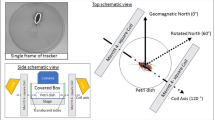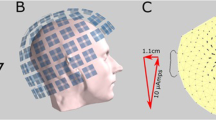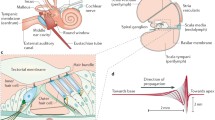Abstract
The possibility of realization of magnetoreception in vertebrates with chains of magnetite nanocrystals (magnetosomes) attached to hair cells of the inner ear is evaluated. To this end, statistical mechanics is applied to analyze fluctuations of stereocilia bundles. Correlation functions of fluctuations of the bundle position and of the number of open mechanoreceptor channels are derived. The sensitivity threshold of the hair cell to applied forces is calculated. Its comparison with the force couple exerted by the magnetosome in the geomagnetic field suggests that a compass magnetoreceptor can be realized with ~ 100 specifically adapted hair cells. To the opposite, no viable magnetic map receptor is possible within this system.




Similar content being viewed by others
References
H. Mouritsen, Nature 558, 50 (2018)
R.Wiltschko and W.Wiltschko, this issue
W. Wiltschko, R. Wiltschko, Science 176, 62 (1972)
E.D. Yorke, J. Theor. Biol. 77, 101 (1979)
J. Kirschvink, J. Gould, BioSystems 13, 181 (1981)
K. Schulten, C.E. Swenberg, A. Weller, Z. Phys. Chem. (NF) 111, 1 (1978)
T. Ritz, S. Adem, K. Schulten, Biophys. J. 78, 707 (2000)
S. Nimpf et al., Curr. Biol. 29, 1 (2019)
P.J. Hore, H. Mouritsen, Annu. Rev. Biophys. 45, 299 (2016)
H. Burda, S. Marhold, T. Westenberger, R. Wiltschko, W. Wiltschko, Experientia 46, 528 (1990)
U. Munro, J.A. Munro, J.B. Phillips, R. Wiltschko, W. Wiltschko, Naturwissenschaften 84(1), 26 (1997)
T. Reichenbach, A.J. Hudspeth, Rep. Prog. Phys. 77, 076601 (2014)
D.Ó. Maoiléidigh, A.J. Ricci, Trends Neurosci. 42, 221 (2019)
G.A. Caprara, A.W. Peng, Mol. Cell. Neurosci. 120, 103706 (2022)
R. Fettiplace, Compr. Physiol. 7, 1197 (2017)
R. Fettiplace, K.X. Kim, Physiol. Rev. 94, 951 (2014)
P. Martin, A.J. Hudspeth, Annu. Rev. Condens. Matter Phys. 12, 29 (2021)
F. Curdt, K. Haase, L. Ziegenbalg, H. Greb, D. Heyers, M. Winklhofer, Sci. Rep. 12, 8803 (2022)
M. Winklhofer, J.L. Kirschvink, J.R. Soc, Interface 7, S273 (2010)
J. Howard, A. Hudspeth, Neuron 1, 189 (1988)
D. Rowland, Y. Roongthumskul, J.-H. Lee, J. Cheon, D. Bozovic, Appl. Phys. Lett. 99, 193701 (2011)
J.H. Lee, J.-W. Kim, M. Levy, A. Kao, S.-H. Noh, D. Bozovic, J. Cheon, ACS Nano 8, 6590 (2014)
C. Kittel, H. Kroemer, Thermal Physics, 2nd edn. (W. H. Freeman, 1980). (Chapter 1)
L.D. Landau, E.M. Lifshitz, Statistical Physics, 3rd edn. (Butterworth-Heinemann, Oxford, 1980). (Chap. 12)
D. Faivre, D. Schueler, Chem. Rev. 108, 4875 (2008)
B.H. Lower, D.A. Bazylinski, J. Mol. Microbiol. Biotechnol. 23, 63 (2013)
D.T. Edmonds, Proc. R. Soc. Lond. B 249, 27 (1992)
A.V. Komolkin et al., J. R. Soc. Interface 14, 20161002 (2017)
Acknowledgements
The author is grateful to M. I. Zhukovskaya for helpful discussions on sensory physiology. This work was supported by the Russian Science Foundation (grant 21-14-00158).
Author information
Authors and Affiliations
Corresponding author
Ethics declarations
Conflict of interest
The author has no competing interests to declare that are relevant to the content of this article.
Rights and permissions
Springer Nature or its licensor holds exclusive rights to this article under a publishing agreement with the author(s) or other rightsholder(s); author self-archiving of the accepted manuscript version of this article is solely governed by the terms of such publishing agreement and applicable law.
About this article
Cite this article
Kavokin, K.V. Compass in the ear: can animals sense magnetic fields with hair cells?. Eur. Phys. J. Spec. Top. 232, 261–268 (2023). https://doi.org/10.1140/epjs/s11734-022-00654-y
Received:
Accepted:
Published:
Issue Date:
DOI: https://doi.org/10.1140/epjs/s11734-022-00654-y




